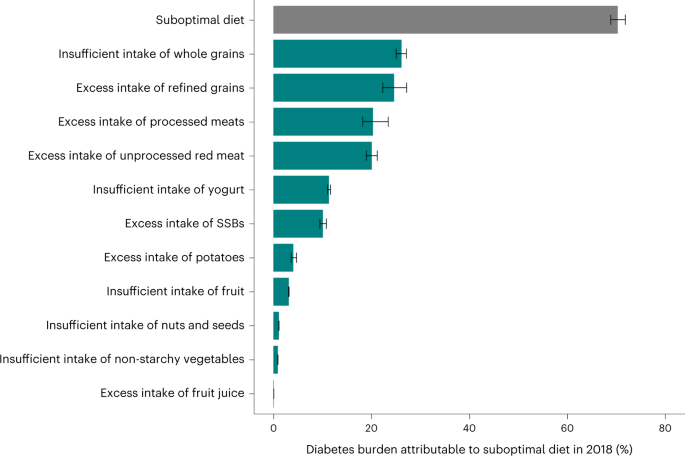2023-04-17 タフツ大学
研究は、1990年から2018年までのデータを調査したもので、世界地域別にどの食事要因がタイプ2糖尿病の負担を引き起こしているかについて貴重な示唆を提供する。
結果は、4月17日にNature Medicine誌に掲載された。
地域的には、中央および東ヨーロッパと中央アジア、特に赤身の肉、加工肉、ジャガイモが豊富な食事が多いポーランドとロシアでは、食事に関連する2型糖尿病の症例が最も多かった。ラテンアメリカとカリブ海、特にコロンビアとメキシコでも発生率が高く、甘い飲み物、加工肉の大量消費、全粒穀物の摂取量が少ないことが原因とされています。
また、11の食事要因のうち、全粒穀物の不足、精製された米や小麦の過剰摂取、加工肉の過剰摂取が、世界的に新規タイプ2糖尿病の増加に寄与した。果汁の過剰摂取や非澱粉野菜、ナッツ、種子の不足は、新規症例にはそれほど影響を与えなかった。
<関連情報>
- https://now.tufts.edu/2023/04/17/study-links-poor-diet-14-million-cases-type-2-diabetes-globally
- https://www.nature.com/articles/s41591-023-02278-8
184カ国の最適でない食事に起因する2型糖尿病発症率 Incident type 2 diabetes attributable to suboptimal diet in 184 countries
Meghan O’Hearn,Laura Lara-Castor,Frederick Cudhea,Victoria Miller,Julia Reedy,Peilin Shi,Jianyi Zhang,John B. Wong,Christina D. Economos,Renata Micha,Dariush Mozaffarian & Global Dietary Database
Nature Medicine Published:17 April 2023
DOI:https://doi.org/10.1038/s41591-023-02278-8

Abstract
The global burden of diet-attributable type 2 diabetes (T2D) is not well established. This risk assessment model estimated T2D incidence among adults attributable to direct and body weight-mediated effects of 11 dietary factors in 184 countries in 1990 and 2018. In 2018, suboptimal intake of these dietary factors was estimated to be attributable to 14.1 million (95% uncertainty interval (UI), 13.8–14.4 million) incident T2D cases, representing 70.3% (68.8–71.8%) of new cases globally. Largest T2D burdens were attributable to insufficient whole-grain intake (26.1% (25.0–27.1%)), excess refined rice and wheat intake (24.6% (22.3–27.2%)) and excess processed meat intake (20.3% (18.3–23.5%)). Across regions, highest proportional burdens were in central and eastern Europe and central Asia (85.6% (83.4–87.7%)) and Latin America and the Caribbean (81.8% (80.1–83.4%)); and lowest proportional burdens were in South Asia (55.4% (52.1–60.7%)). Proportions of diet-attributable T2D were generally larger in men than in women and were inversely correlated with age. Diet-attributable T2D was generally larger among urban versus rural residents and higher versus lower educated individuals, except in high-income countries, central and eastern Europe and central Asia, where burdens were larger in rural residents and in lower educated individuals. Compared with 1990, global diet-attributable T2D increased by 2.6 absolute percentage points (8.6 million more cases) in 2018, with variation in these trends by world region and dietary factor. These findings inform nutritional priorities and clinical and public health planning to improve dietary quality and reduce T2D globally.


